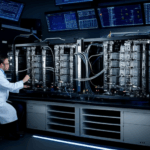“`html
Unveiling the Future: How Computer Vision is Transforming Industries
Introduction
Computer vision, a subset of artificial intelligence, involves teaching computers to interpret and understand the visual world from digital images or videos. This technology has emerged as a cornerstone in today’s rapidly evolving technological landscape, offering unprecedented opportunities for innovation and efficiency across various industries. Over the years, computer vision has evolved from basic image processing techniques to sophisticated systems capable of recognizing patterns, objects, and behaviors with remarkable accuracy. Its potential to revolutionize industries is immense, ranging from healthcare and manufacturing to retail, automotive, and agriculture.
Key Concepts of Computer Vision
Definition and Core Principles: Computer vision aims to replicate human vision by enabling machines to analyze and interpret visual information. It involves several key components, including image acquisition, preprocessing, feature extraction, and object recognition. The core principle lies in converting raw pixel data into meaningful insights that can be used for decision-making.
Role of Algorithms, Machine Learning, and Deep Learning: Algorithms form the backbone of computer vision systems, guiding the processing and interpretation of visual data. Machine learning and deep learning have significantly advanced these capabilities by allowing systems to learn from vast datasets and improve their accuracy over time. Convolutional Neural Networks (CNNs), a type of deep learning model, are particularly effective in identifying patterns and features within images, making them indispensable in modern computer vision applications.
Applications Across Industries
Healthcare
In healthcare, computer vision plays a pivotal role in medical imaging, enhancing diagnostic accuracy and efficiency. Systems powered by computer vision can analyze X-rays, MRIs, and other imaging modalities to detect abnormalities and provide detailed insights. This technology also supports surgical assistance by providing real-time guidance during complex procedures, reducing the risk of errors. Additionally, computer vision is employed in patient monitoring to track vital signs and detect early signs of complications, ensuring timely intervention.
Manufacturing
The manufacturing industry benefits greatly from computer vision in areas such as quality control and defect detection. Automated inspection systems equipped with computer vision can swiftly identify flaws in products, ensuring only high-quality items reach consumers. Furthermore, computer vision enhances robotic process automation by enabling robots to perform tasks with greater precision and adaptability. In supply chain management, it optimizes inventory tracking and streamlines logistics operations, contributing to increased efficiency and cost savings.
Retail
In retail, computer vision powers inventory management by automating stock counts and tracking product movements. It also enables customer behavior analysis, helping retailers understand purchasing patterns and preferences. Personalized shopping experiences are made possible through computer vision, which can recommend products tailored to individual tastes. Smart checkout systems and virtual try-on technologies further enhance the customer experience, making shopping more convenient and engaging.
Automotive
The automotive sector leverages computer vision in autonomous driving systems, where it helps vehicles perceive their surroundings and navigate safely. Advanced driver-assistance systems (ADAS) utilize computer vision for features like lane departure warnings, collision avoidance, and adaptive cruise control. These innovations not only improve road safety but also pave the way for fully autonomous vehicles, potentially transforming transportation as we know it.
Agriculture
In agriculture, computer vision aids in crop monitoring, enabling farmers to assess plant health and predict yields accurately. It also assists in pest detection, helping to prevent infestations before they cause significant damage. Precision farming practices, guided by computer vision, optimize resource usage, leading to more sustainable and productive agricultural operations. Automated harvesting systems further streamline farming processes, reducing labor costs and increasing efficiency.
Challenges and Ethical Considerations
Despite its numerous benefits, computer vision faces several challenges. Data privacy concerns arise as systems collect and process vast amounts of personal information. Bias in algorithms can lead to unfair outcomes, especially in sensitive areas like hiring and law enforcement. Robust security measures are essential to protect against unauthorized access and malicious attacks. Ethical considerations include job displacement due to automation and the importance of transparency in decision-making processes. Addressing these challenges is crucial for the responsible deployment of computer vision technology.
Future Prospects
The future of computer vision holds exciting possibilities. Advancements in hardware and software will continue to enhance the capabilities of computer vision systems, enabling more accurate and efficient solutions. Potential new applications include smart cities, where computer vision can monitor public spaces for safety and efficiency. In entertainment, it could revolutionize gaming and virtual reality experiences. As computer vision continues to evolve, its transformative impact across industries will only grow, shaping the future in ways we can only begin to imagine.
Conclusion
Computer vision has already begun to revolutionize industries, offering unparalleled opportunities for innovation and efficiency. From healthcare and manufacturing to retail, automotive, and agriculture, its applications are vast and varied. While challenges and ethical considerations must be addressed, the potential for future advancements is immense. As computer vision continues to evolve, it will undoubtedly play a pivotal role in shaping the future, transforming industries and enhancing our daily lives in countless ways.
“`


